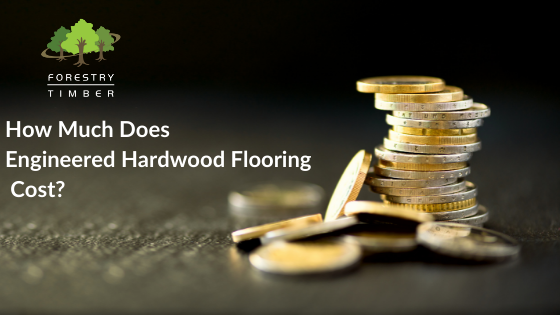
Great question … although somewhat on par with asking; How long is a piece of string?
Smart remarks aside, that question isn’t so easy to answer. Prices for flooring tend to vary widely based on any number of variables – not least of which being the quality of engineered hardwood flooring you choose.
A Strong Core is Crucial

Many engineered hardwood flooring manufacturers use six-to-seven layers of plywood as the core layer of their flooring. While strong – and developed to provide dimensional stability (the ability of the floor to withstand fluctuations in temperature and humidity) – an engineered wood floor with a plywood core does not offer the same dimensional stability as a core consisting of staves of wood.

Sound confusing? It doesn’t need to be.
As an example, Forestry Timber uses top-quality Hevea wood as the core of all its engineered hardwood flooring. Hevea is a plantation wood that has the same density and strength as White Oak. Being sourced from a plantation means that we are using the wood at the end of its natural lifecycle, making room for younger trees to grow and thrive.

In terms of strength and density, using staves of Hevea wood as the core of our floors means that, by default, your floor is stronger than one with a plywood core. What that means in real terms is that the floor will be less susceptible to warping, cupping, or buckling as a result of fluctuations in both temperature (Western Canada in winter anyone?) and humidity (think of Brisbane on the east coast of Australia).
Start With the Best
At Forestry Timber, we use Western European Oak for the majority of our flooring material – although we do offer a selection of American Pecan, European Ash, and Tasmanian Oak as well.

You might wonder why it matters that our oak is sourced from western Europe – and we’re happy to share. The market for wood and wood products is particularly competitive. As tends to happen, heavy demand drives illegal practices; in this instance, illegal logging – which accounts for up to USD $152 billion annually.
At Forestry Timber, we are committed to using only legally-sourced wood, from sustainably managed forests and meeting strict environmental guidelines to make sure our product is the best it can be – for our customers, every employee and their families, and our beautiful planet. And we have maintained that commitment from the day we started this business, over 30 years ago.
The Top Layer of Your Floor
The top layer of engineered hardwood flooring is called a wear layer, or veneer. This is the top layer of wood you see on your floor. At Forestry Timber, we pride ourselves on producing flooring that has a beautiful, strong, well-protected veneer.
There are three types of veneers used for engineered hardwood flooring; the first of which is a peeled veneer. This is, essentially, where layers are peeled off the log, creating thin sheets of wood that then become the top layer of the floor. Peeling is an efficient method of creating a veneer and will often exhibit wide variations in the shape and direction of the grain.
The second method of creating a veneer is by slicing. A process used less often than peeling, logs are sliced along their length, resulting in a true depiction of the natural growth patterns and grain of the wood.
The third type of veneer – and the one we use at Forestry Timber – is a sawn veneer. The process is similar to slicing, except, as the name states, a saw is used instead of a standard blade. Cutting with a saw means the veneers are thicker, making your floor more stable. Sawn veneers highlight the natural beauty of each tree.

Colours, Stains, and Finishes
The myriad colours we offer are achieved through varied, sometimes multiple processes like smoking, fuming, and the use of our proprietary reactive stain technology, creating a floor with deeply saturated colours.
Durability is an important characteristic of any floor – and one we have worked hard to perfect. We use UV Oil or UV urethane to create a strong, long-lasting, resilient, and scratch-resistant finish on our floors. Over time, the natural wear and tear of daily life will show on any floor, resulting in a slightly dull surface. Regular cleaning and maintenance of your floor – especially if you use one of our recommended wood polishes and/or cleaning products – usually rectifies the situation.
Finally …
As with most things, you get what you pay for. The quality and cost of the materials used, labour, supply chain, shipping, installation, etc. – each of these variables factor into the price of your floor.

The other way to look at is – if you amortize the cost of your stunning new floor over roughly 25 years and combine it with the myriad benefits of having an engineered hardwood floor in your home or commercial space – the cost is minimal.
It’s Up to You
Ultimately, the floor you choose to install in your home or business depends on what best suits your needs.

We at Forestry Timber are proud of the floors we produce and are confident that you will be happy with your purchase both now and for decades to come.
For more information, or to find one of our many distributors worldwide, please visit any one of our brand websites: Woodline Parquetry, TimberTop, FloorArt Parquetry Elyseum Fertigparkett, or Sienna Parquetry, or contact any of our sales team and they will be more than happy to help.
Hardwood flooring engineered for living, Designed to Impress.
